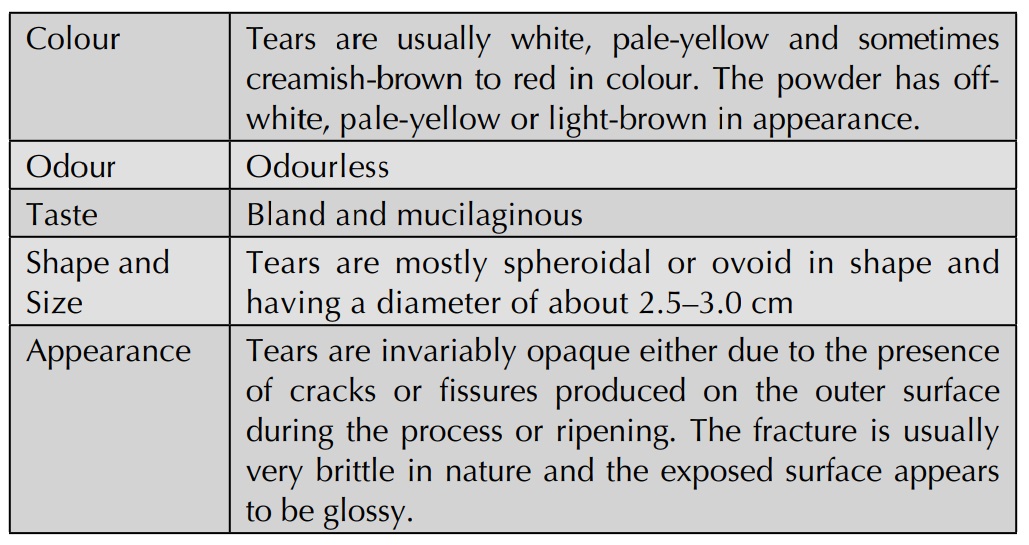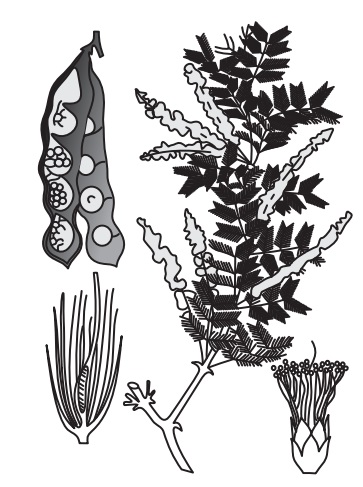Acacia Gum
| Home | | Pharmacognosy |Chapter: Pharmacognosy and Phytochemistry : Drugs Containing Carbohydrates and Derived Products
Acacia senegal is the characteristic species in the drier parts of Anglo-Egyptian Sudan and the northern Sahara, and is to be found throughout the vast area from Senegal to the Red Sea and to eastern India. It extends southwards to northern Nigeria, Uganda, Kenya, Tanzania and southern Africa. The plant is extensively found in Arabia, Kordofan (North-East Africa), Sri Lanka and Morocco.
ACACIA GUM
Synonyms
Acacia gum, Acacia vera, Egyptian thorn, Gummi africanum,
Gum Senegal, Gummae mimosae, Kher, Sudan gum arabic, Somali gum, Yellow thorn,
Indian Gum and Gum Arabic.
Biological Source
According to the USP, acacia is the dried gummy exuda-tion
obtained from the stems and branches of Acacia
senegal (L.) Willd or other African species of Acacia. In India, it is
found as dried gummy exudation obtained from the stems and branches of Acacia arabica Willd, belonging to
family Leguminosae
Geographical Source
Acacia senegal is the characteristic species in the
drier parts of Anglo-Egyptian Sudan
and the northern Sahara, and is to be found throughout the vast area from
Senegal to the Red Sea and to eastern India. It extends southwards to northern
Nigeria, Uganda, Kenya, Tanzania and southern Africa. The plant is extensively
found in Arabia, Kordofan (North-East Africa), Sri Lanka and Morocco. In India
it is found chiefly in Punjab, Rajasthan and Western Ghats. Sudan is the major
producer of this gum and caters for about 85% of the world supply.
Cultivation and Collection
Acacia is a thorny tree up to 6 m in height. In Sudan, gum
is tapped from specially cultivated trees while in Senegam-bia, because of
extremes of climate; cracks are produced on the tree and the gum exudes and is
collected from the wild plants. Acacia trees can be cultivated by sowing the
seeds in the poor, exhausted soil containing no minerals. The trees also grow
as such by seed-dispersal.
Gum is collected by natives from 6 to 8 years old trees,
twice a year in dry weather in November or in February— March. Natives cut the
lower thorny branches to facilitate the working and by means of an axe make 2–3
ft long and 2–3 inches broad incision on the stem and branches, loosen the bark
by axe and remove it, taking care not to injure the cambium and xylem. Usually
they leave a thin layer of bark on xylem. If xylem is exposed, white ant enters
the plant and gum is not produced. After injury in winter gum exudes after 6–8
weeks while in summer after 3–4 weeks. It is believed that bacteria finding
their way through the incision are more active in summer and gum is produced
quickly. The exuded gum is scraped off, collected in leather bags and then is
cleaned by separating debris of bark and wood and separating sand, etc., by
sieving.
Gum is dried in the sun by keeping it in trays in thin
layers for about 3 weeks when bleaching takes place and it becomes whiter. This
result in uneven contraction and cracks and fissures are formed on its outer
surface and as a result original transparent gum becomes opaque. This process
is called ripening of the gum.
Morphology


History
Gum was brought from the Gulf of Aden to Egypt in the 17th
B.C., and in the works of Theophrastus it is spoken of as a product of Upper
Egypt. The West African product was imported by the Portuguese in the fifteenth
century. Until quite recently, commerce in the Sudan was in the hands of a
number of local merchants, but it is now entirely controlled by the Gum Arabic
Company Ltd., a concessional company set up by the Sudanese Government. This
Company alone produces about 40,000 tonnes per annum.
Chemical constituents
Acacia consists principally of arabin, which is a complex
mixture of calcium, magnesium and potassium salts of arabic acid. Arabic acid
is a branched polysaccharide that yields L-arabinose, D-galactose, D-glucuronic
acid and L-rhamnose on hydrolysis. 1, 3-Linked D-galactopyranose units form the
backbone chain of the molecule and the terminal residues of the 1, 6-linked side
chains are primarily uronic acids. Acacia contains 12–15% of water and several
occluded enzymes such as oxidases, peroxidases and pectinases. The total ash
content should be in the range of 2.7–4.0%.
Chemical Tests
1. Lead
acetate test: An
aqueous solution of acacia when treated with lead acetate solution yields a heavy white
precipitate.
2. Reducing
sugars test: Hydrolysis
of an aqueous solution of acacia with dilute HC1 yields reducing sugars
whose presence are ascertained by boiling with Fehling’s solution to give a
brick-red precipitate of cuprous oxide.
3. Blue
colouration due to enzyme: When
the aqueous
solution of acacia is treated with benzidine in alcohol together with a few
drops of hydrogen peroxide (H2O2), it gives rise to a
distinct blue colour due to the presence of oxidases enzyme.
4. Borax
test: An aqueous
solution of acacia affords a stiff translucent mass on treatment with borax.
5. Specific
test: A 10%
aqueous solution of acacia fails to produce any precipitate with dilute solution of lead
acetate (a clear distinction from Agar and Tragacanth); it does not give any
colour change with Iodine solution (a marked distinction from starch and
dextrin); and it never produces a bluish-black colour with FeCl3
solution (an apparent distinction from tannins).
Uses
The mucilage of acacia is employed as a demulcent. It is
used extensively as a vital pharmaceutical aid for emulsification and to serve
as a thickening agent. It finds its enormous application as a binding agent for
tablets, for example, cough lozenges. It is used in the process of
‘granulation’ for the manufacturing of tablets. It is considered to be the gum
of choice by virtue of the fact that it is quite com-patible with other plant
hydrocolloids as well as starches, carbohydrates and proteins. It is used in
combination with gelatin to form conservates for micro-encapsulation of drugs.
It is employed as colloidal stabilizer. It is used extensively in making of
candy and other food products. Gum acacia solution has consistency similar to
blood and is administered intravenously in haemodialysis. It is used in the
manufacture of adhesives and ink, and as a binding medium for marbling colours.
Allied Drugs
Talka gum is usually much broken and of very
variable composition, some of the
tears being almost colourless and others brown.
Ghatti or Indian gum is derived from
Anogeissus latifolia (Combretaceae). It is produced in much the same
localities as sterculia gum, and is harvested and prepared in a similar manner.
It resembles talka in possessing tears of various colours. Some of the tears
are vermiform in shape and their surface shows fewer cracks than even the
natural acacia. Aqueous dispersions of the gum have a viscosity intermedi-ate
between those of acacia and sterculia gums.
West African Gum Combretum, obtained from Com-bretum nigricans, is not permitted
as a food additive but is exploited
as an adulterant of gum arabic. Unlike the latter in which the rhamnose and
uronic acid units are chain terminal, in gum combretum these moieties are
located within the polysaccharides chain.
Many other gums of the acacia type are occasionally met with
in commerce, and many gum exudates of the large genus Acacia have been given chemotaxonomic con-sideration.
Toxicology
Acacia is essentially nontoxic when ingested. Allergic
reac-tions to the gum and powdered forms of acacia have been reported and
include respiratory problems and skin lesions.
Acacia contains a peroxidase enzyme, which is typically
destroyed by brief exposure to heat. If not inactivated, this enzyme forms
coloured complexes with certain amines and phenols and enhances the destruction
of many pharmaceutical products including alkaloids and readily oxidizable
compounds, such as some vitamins. Acacia gum reduces the antibacterial
effectiveness of the preservative methyl-p-hydroxybenzoate against Pseudomonas aeruginosa presumably by
offering physical barrier protection to the microbial cells from the action of
the preservative. A trypsin inhibitor also has been identified, but the
clinical significance of the presence of this enzyme is not known.
Marketed Product
Dental cream and Evecare syrup and capsule manufactured by
Himalaya Drug Company.
